Vertical Heterogeneity of the Shale Reservoir in the Lower Silurian Longmaxi Formation: Analogy between the Southeastern and Northeastern Sichuan Basin, SW China
Abstract
:1. Introduction
2. Geological Setting
3. Sampling and Analytic Methods
4. Results and Discussion
4.1. Vertical variation of Lithofacies
4.2. Mineralogical Characteristic of LSL Shale
4.3. Characteristic of TOC Content
4.4. Porosity and Permeability
4.5. Compared to the LSL Shale in Southeastern Sichuan Basin
5. Conclusions
Acknowledgments
Author Contributions
Conflicts of Interest
References
- Curtis, J.B. Fractures shale-gas system. AAPG Bull. 2002, 86, 1921–1938. [Google Scholar]
- Pan, L.; Xiao, X.M.; Tian, H.; Zhou, Q.; Chen, J.; Li, T.F.; Wei, Q. A preliminary study on the characterization and controlling factors of porosity and pore structure of the Permian shales in Lower Yangtze region, Eastern China. Int. J. Coal Geol. 2015, 146, 68–78. [Google Scholar] [CrossRef]
- Aljamaan, H.; Holmes, R.; Vishal, V.; Haghpanah, R.; Wilcox, J.; Kovscek, A.R. CO2 storage and flow capacity measurements on idealized shales from dynamic breakthrough experiments. Energy Fuels 2017, 31, 1193–1207. [Google Scholar] [CrossRef]
- Mahanta, B.; Tripathy, A.; Vishal, V.; Singh, T.N.; Ranjith, P.G. Effects of strain rate on fracture toughness and energy release rate of gas shales. Eng. Geol. 2017, 218, 39–49. [Google Scholar] [CrossRef]
- Vishal, V.; Jain, N.; Singh, T.N. 3-D modeling of propagation of hydraulic fractures in shale at different injection pressures. Sustain. Environ. Res. 2015, 25, 217–225. [Google Scholar]
- Firouzi, M.; Alnoaimi, K.; Kovscek, A.; Wilcox, J. Klinkenberg effect on predicting and measuring helium permeability in gas shales. Int. J. Coal Geol. 2014, 123, 62–68. [Google Scholar] [CrossRef]
- Chen, L.; Lu, Y.C.; Jiang, S.; Li, J.Q.; Guo, T.L.; Luo, C. Heterogeneity of the Lower Silurian Longmaxi marine shale in the Southeast Sichuan Basin of China. Mar. Pet. Geol. 2015, 65, 232–246. [Google Scholar] [CrossRef]
- Xiong, F.Y.; Jiang, Z.X.; Tang, X.L.; Li, Z.; Bi, H.; Li, W.B.; Yang, P.P. Characteristics and origin of the heterogeneity of the Lower Silurian Longmaxi marine shale in Southeastern Chongqing, SW China. J. Nat. Gas Sci. Eng. 2015, 27, 1389–1399. [Google Scholar] [CrossRef]
- Wang, Y.M.; Dong, D.Z.; Li, X.J.; Huang, J.L.; Wang, S.F.; Wu, W. Stratigraphic sequence and sedimentary characteristics of Lower Silurian Longmaxi Formation in Sichuan Basin and its peripheral areas. Int. Nat. Gas Ind. B 2015, 2, 222–232. [Google Scholar] [CrossRef]
- Dai, J.X.; Zou, C.N.; Liao, S.M.; Dong, D.Z.; Ni, Y.Y.; Huang, J.L.; Wu, W.; Gong, D.Y.; Huang, S.P.; Hu, G.Y. Geochemistry of the extremely high thermal maturity Longmaxi shale gas, southern Sichuan Basin. Org. Geochem. 2014, 74, 3–12. [Google Scholar] [CrossRef]
- Tang, X.L.; Jiang, Z.X.; Li, Z.; Gao, Z.Y.; Bai, Y.Q.; Zhao, S.; Feng, J. The effect of the variation in material composition on the heterogeneous pore structure of high-maturity shale of the Silurian Longmaxi Formation in the Southeastern Sichuan Basin, China. J. Nat. Gas Sci. Eng. 2015, 23, 464–473. [Google Scholar] [CrossRef]
- Ji, W.M.; Song, Y.; Jiang, Z.X.; Chen, L.; Li, Z.; Yang, X.; Meng, M.M. Estimation of marine shale methane adsorption capacity based on experimental investigations of Lower Silurian Longmaxi Formation in the Upper Yangtze Platform, South China. Mar. Pet. Geol. 2015, 68, 94–106. [Google Scholar] [CrossRef]
- Wu, J.; Liang, F.; Bai, W.H.; Lin, W.; Zhao, R. Exploration prospect of Lower Silurian Longmaxi Formation shale gas in Northeastern Chongqing City. Spec. Oil Gas Reserv. 2015, 22, 50–55, (In Chinese with English abstract). [Google Scholar]
- Westphal, H.; Eberli, G.P.; Smith, L.B.; Grammer, G.M.; Kislak, J. Reservoir characterization of the Mississippian Madison Formation, Wind River Basin, Wyoming. AAPG Bull. 2004, 88, 405–432. [Google Scholar] [CrossRef]
- Jiang, Z.X.; Guo, L.; Liang, C. Lithofacies and sedimentary characteristics of the Silurian Longmaxi shale in the Southeastern Sichuan Basin, China. J. Palaeogeogr. 2013, 2, 238–251. [Google Scholar]
- Eaton, T.T. On the importance of geological heterogeneity for flow simulation. Sediment. Geol. 2006, 184, 187–201. [Google Scholar] [CrossRef]
- Weber, K. Influence of common sedimentary structures on fluid flow in reservoir models. J. Pet. Technol. 1982, 34, 665–672. [Google Scholar] [CrossRef]
- Cartoon, M.R. The effects of reservoir heterogeneity on predicted waterflood performance in the Dodsland Field. J. Can. Pet. Technol. 1993, 34, 31–38. [Google Scholar]
- Ouchi, H.; Foster, T.; Sharma, M.M. Effect of reservoir heterogeneity on the vertical migration of hydraulic fractures. J. Pet. Sci. Eng. 2016, 151, 384–408. [Google Scholar] [CrossRef]
- Burchette, T.P.; Wright, V.P.; Faulkner, T.J. Oolitic sandbody depositional models and geometries, Mississippian of Southwest Britain: Implications for petroleum exploration in carbonate ramp settings. Sediment. Geol. 1990, 68, 87–115. [Google Scholar] [CrossRef]
- Kerans, C.; Lucia, F.J.; Senger, R.K. Integrated characterization of carbonate ramp reservoirs using Permian San Andres Formation outcrop analogs. AAPG Bull. 1994, 78, 181–216. [Google Scholar]
- Wang, X.Z.; Zhang, L.X.; Gao, C. The heterogeneity of lacustrine shale gas reservoir in Yanchang formation, Xiasiwan area, Ordos Basin. Acta Geol. Sin. Eng. 2015, 89, 99–101. [Google Scholar] [CrossRef]
- Houben, M.E.; Desbois, G.; Urai, J.L. A comparative study of representative 2D microstructures in shaly and sandy facies of opalinus clay (Mont Terri, Switzerland) inferred form BIB-SEM and MIP methods. Mar. Pet. Geol. 2014, 49, 143–161. [Google Scholar] [CrossRef]
- Li, R.X.; Dong, S.W.; Lehrmann, D.; Duane, L.Z. Tectonically driven organic fluid migration in the Dabashan Foreland Belt: Evidenced by geochemistry and geothermometry of vein-filling fibrous calcite with organic inclusions. J. Asian Earth Sci. 2013, 75, 202–212. [Google Scholar] [CrossRef]
- Ma, Y.; Zhong, N.N.; Li, D.H.; Pan, Z.J.; Cheng, L.J.; Liu, K.Y. Organic matter/clay mineral intergranular pores in the Lower Cambrian Lujiaping shale in the north-eastern part of the Upper Yangtze area, China: A possible microscopic mechanism for gas preservation. Int. J. Coal Geol. 2015, 137, 38–54. [Google Scholar] [CrossRef]
- Meng, Q.R.; Zhang, G.W. Geologic framework and tectonic evolution of the Qinling Orogen, Central China. Tectonophysics 2000, 323, 183–196. [Google Scholar] [CrossRef]
- Nie, H.K.; Zhang, J.C.; Bao, S.J.; Bian, R.K.; Song, X.J.; Liu, J.B. Shale gas accumulation conditions of the Upper Ordovician–Lower Silurian in Sichuan Basin and its periphery. Oil Gas Geo. 2012, 33, 335–345, (In Chinese with English abstract). [Google Scholar]
- Pecharsky, V.K.; Zavalij, P.Y. Fundamentals of Powder Diffraction and Structural Characterization of Minerals; Kluwer Academic Publishers: New York, NY, USA, 2003; p. 713. [Google Scholar]
- Jacob, H. Dispersed solid bitumens as an indicator for migration and maturity in prospecting for oil and gas. Erdöl Kohle Erdgas Petrochem. 1985, 38, 365–392. [Google Scholar]
- Chen, L.; Lu, Y.C.; Jiang, S.; Li, J.Q.; Guo, T.L.; Luo, C.; Xing, F.C. Sequence stratigraphy and its application in marine shale gas exploration: A case study of the Lower Silurian Longmaxi Formation in the Jiaoshiba shale gas field and its adjacent area in southeast Sichuan Basin, SW China. J. Nat. Gas Sci. Eng. 2015, 27, 410–423. [Google Scholar] [CrossRef]
- Shi, X.Y.; Jiang, G.Q.; Zhang, C.H.; Gao, L.Z.; Liu, J. Sand veins and MISS from the Mesoproterozoic black shale (ca. 1.7 Ga) in north China: Implication for methane degassing from microbial mats. Sci. China-Earth Sci. 2008, 51, 1525–1536. [Google Scholar] [CrossRef]
- Jarvie, D.M.; Hill, R.J.; Ruble, T.E.; Pollastro, R.M. Unconventional shale-gas system: The Mississippian Barnett shale on north-center Texas as one model for thermogenic shale-gas assessment. AAPG Bull. 2007, 91, 475–499. [Google Scholar] [CrossRef]
- Zhang, T.W.; Ellis, G.S.; Ruppel, S.C.; Milliken, K.; Yang, R.S. Effect of organic-matter type and thermal maturity on methane adsorption in shale-gas systems. Org. Geochem. 2012, 47, 120–131. [Google Scholar] [CrossRef]
- Gasparik, M.; Bertier, P.; Gensterblum, Y.; Ghanizadeh, A.; Krooss, B.M.; Littke, R. Geological controls on the methane storage capacity in organic-rich shales. Int. J. Coal Geol. 2013, 123, 34–51. [Google Scholar] [CrossRef]
- Chalmers, G.R.L.; Ross, D.J.K.; Bustin, R.M. Geological controls on matrix permeability of Devonian gas shales in the Horn River and Liard Basins, Northeastern British Columbia, Canada. Int. J. Coal Geol. 2012, 103, 120–131. [Google Scholar] [CrossRef]
- Tian, H.; Pan, L.; Xiao, X.M.; Wilkins, R.W.T.; Meng, Z.P.; Huang, B.J. A preliminary study on the pore characterization of Lower Silurian black shales in the Chuandong Thrust Fold Belt, southwestern China using low pressure N2 adsorption and FE-SEM methods. Mar. Petrol. Geol. 2013, 48, 8–19. [Google Scholar] [CrossRef]
- Zheng, H.R.; Gao, B.; Peng, Y.M.; Nie, H.K.; Yang, F.R. Sedimentary evolution and shale gas exploration direction of the Lower Silurian in Middle-Upper Yangtze area. J. Palaeogeogr. 2013, 15, 645–656, (In Chinese with English abstract). [Google Scholar]
- Cheng, L.X.; Wang, Y.J.; Chen, H.D.; Wang, Y.; Zhong, Y.J. Sedimentary and burial environment of black shales of Sinian to Early Palaeozoic in Upper Yangtze region. Acta Pet. Sin. 2013, 29, 2906–2912. [Google Scholar]
- Guo, T.L.; Zhang, H.R. Formation and enrichment mode of Jiaoshiba shale gas field, Sichuan Basin. Pet. Explor. Dev. 2014, 4, 28–36, (In Chinese with English abstract). [Google Scholar] [CrossRef]

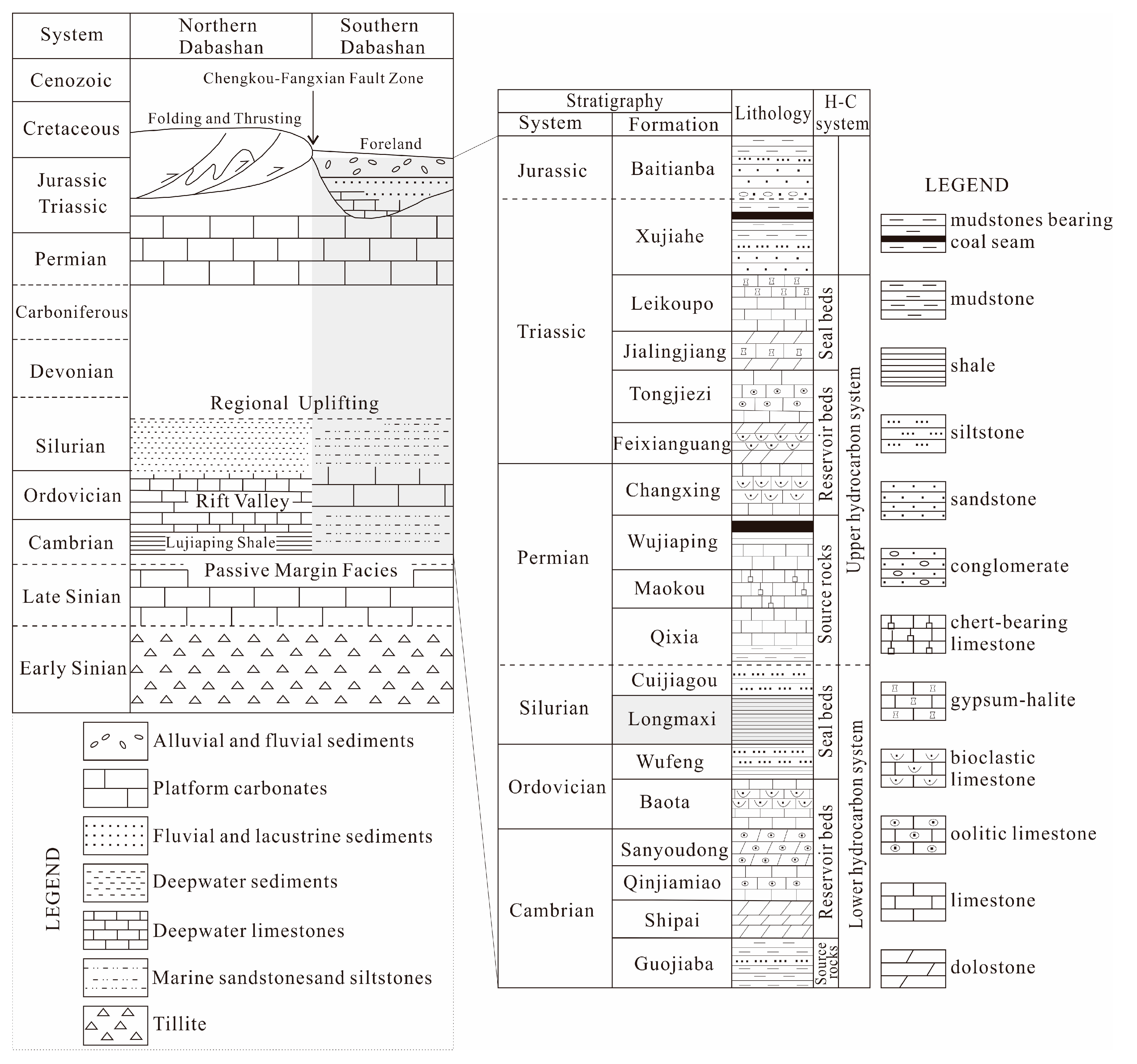
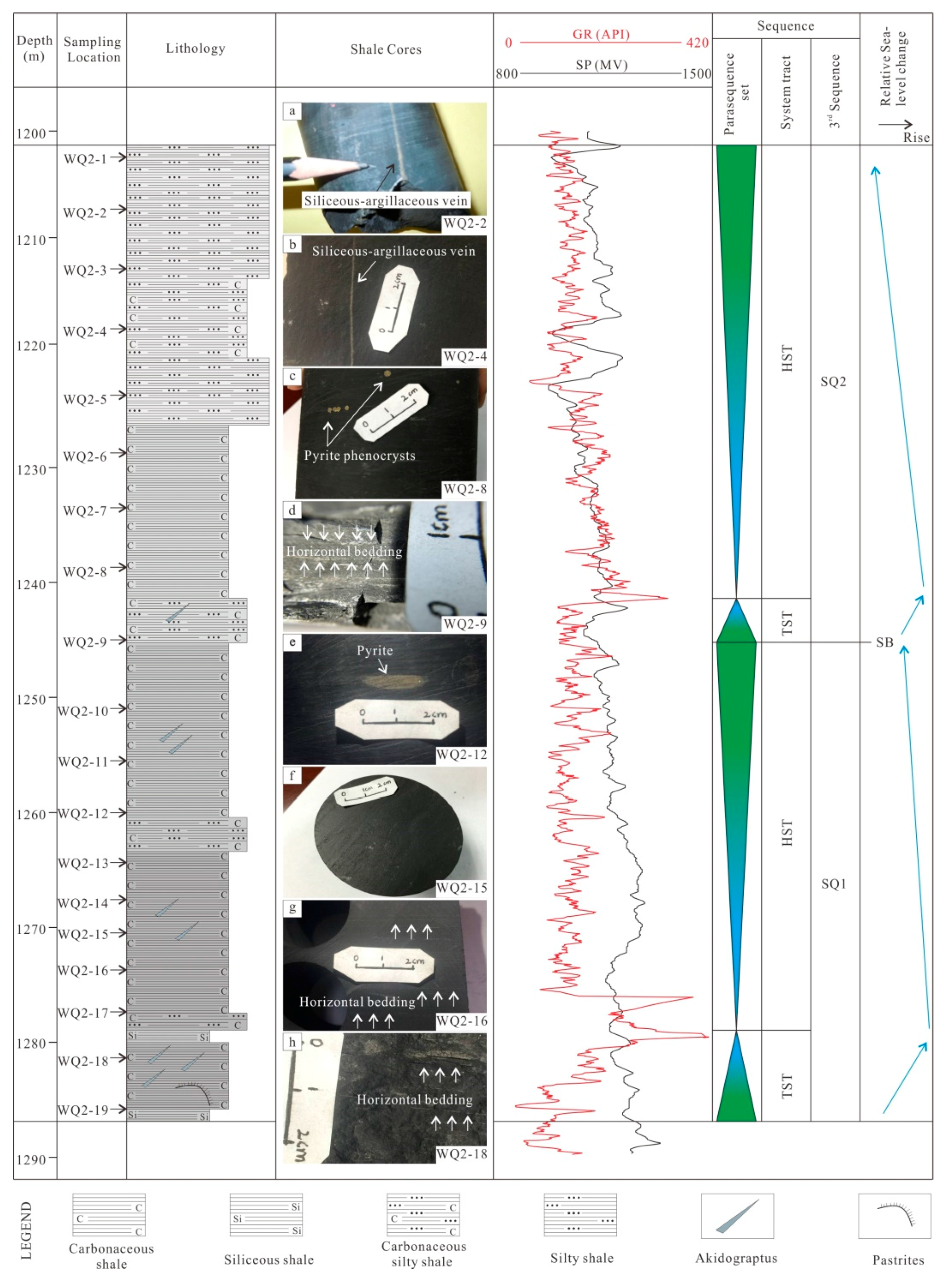

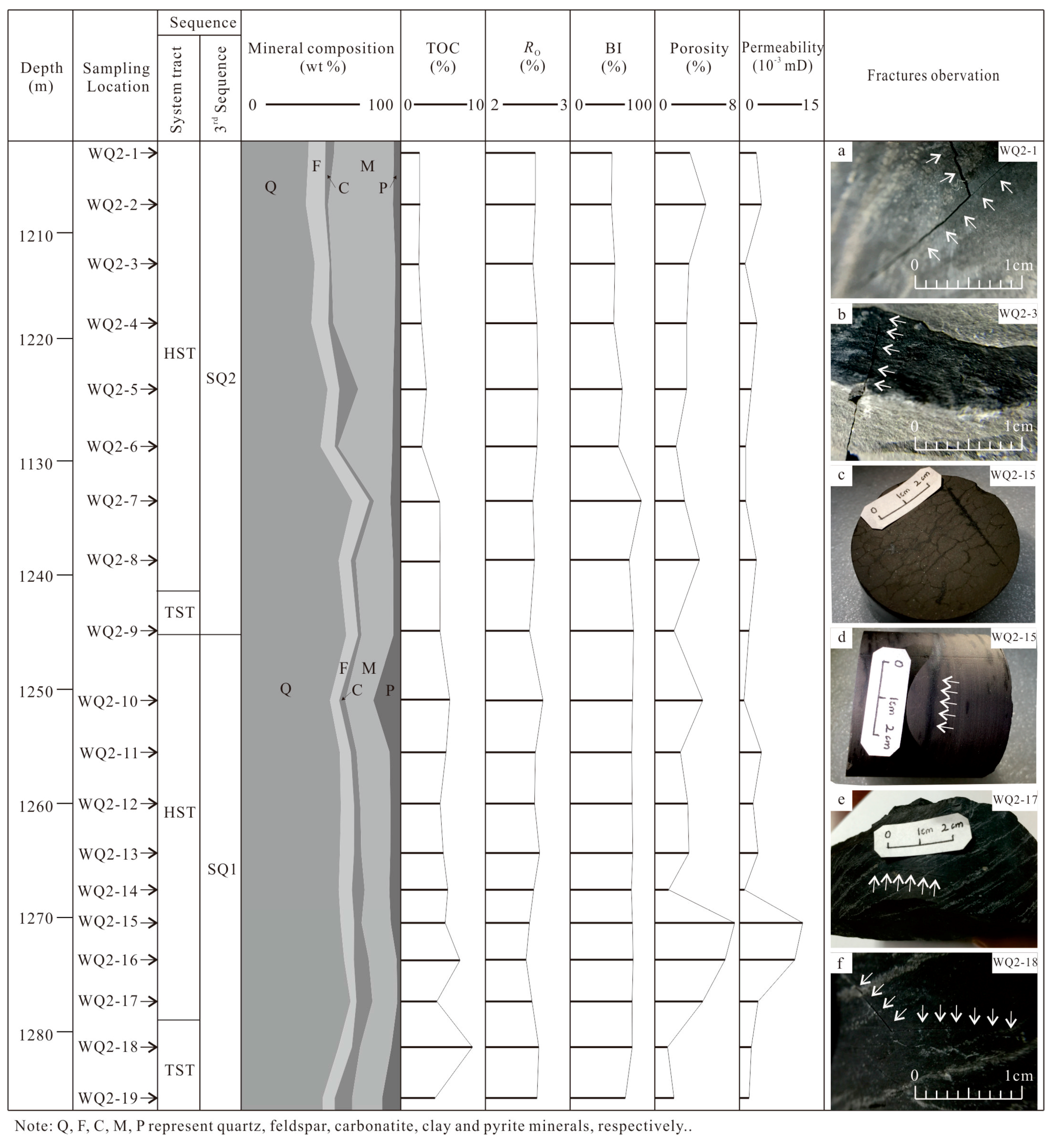
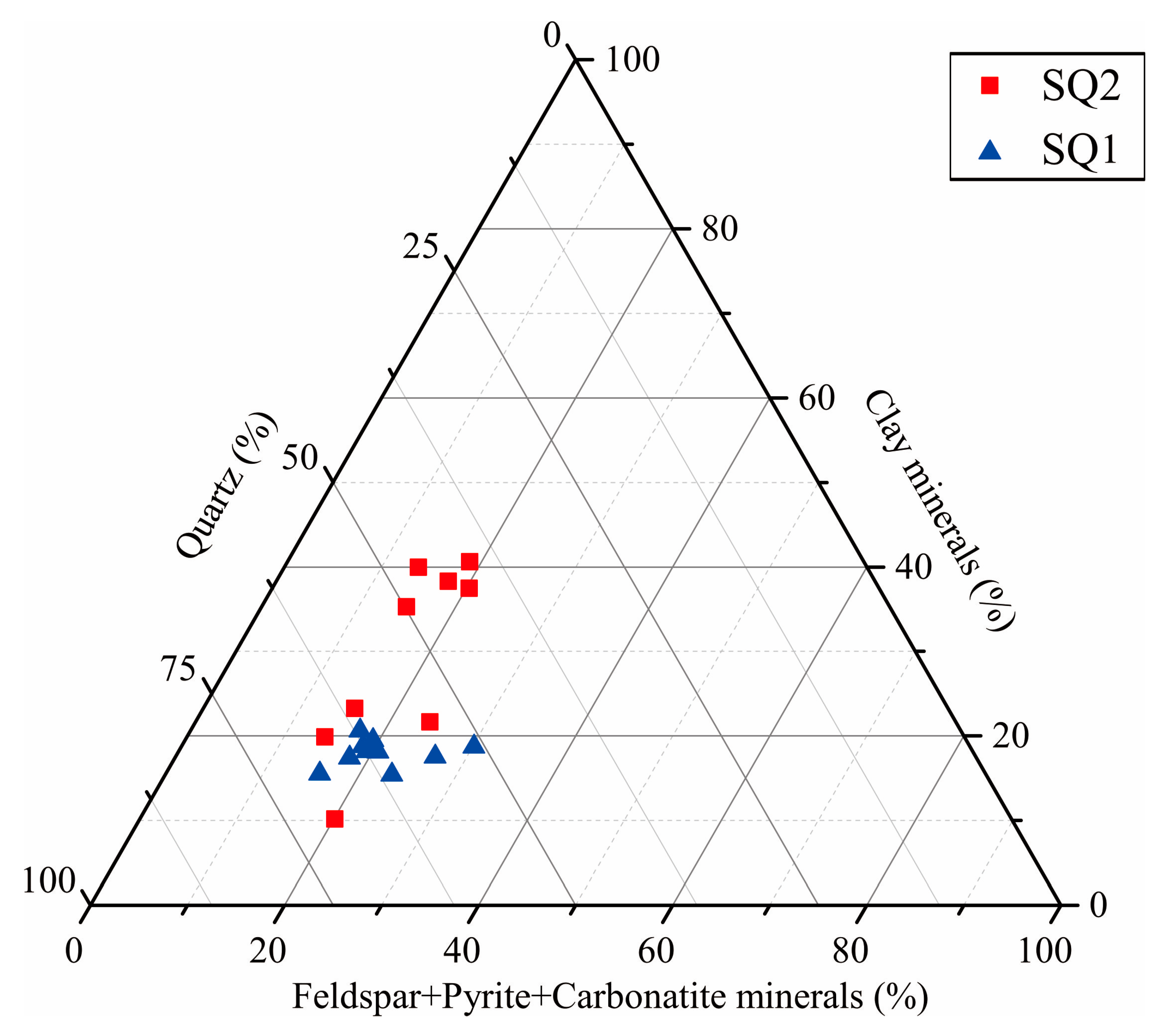
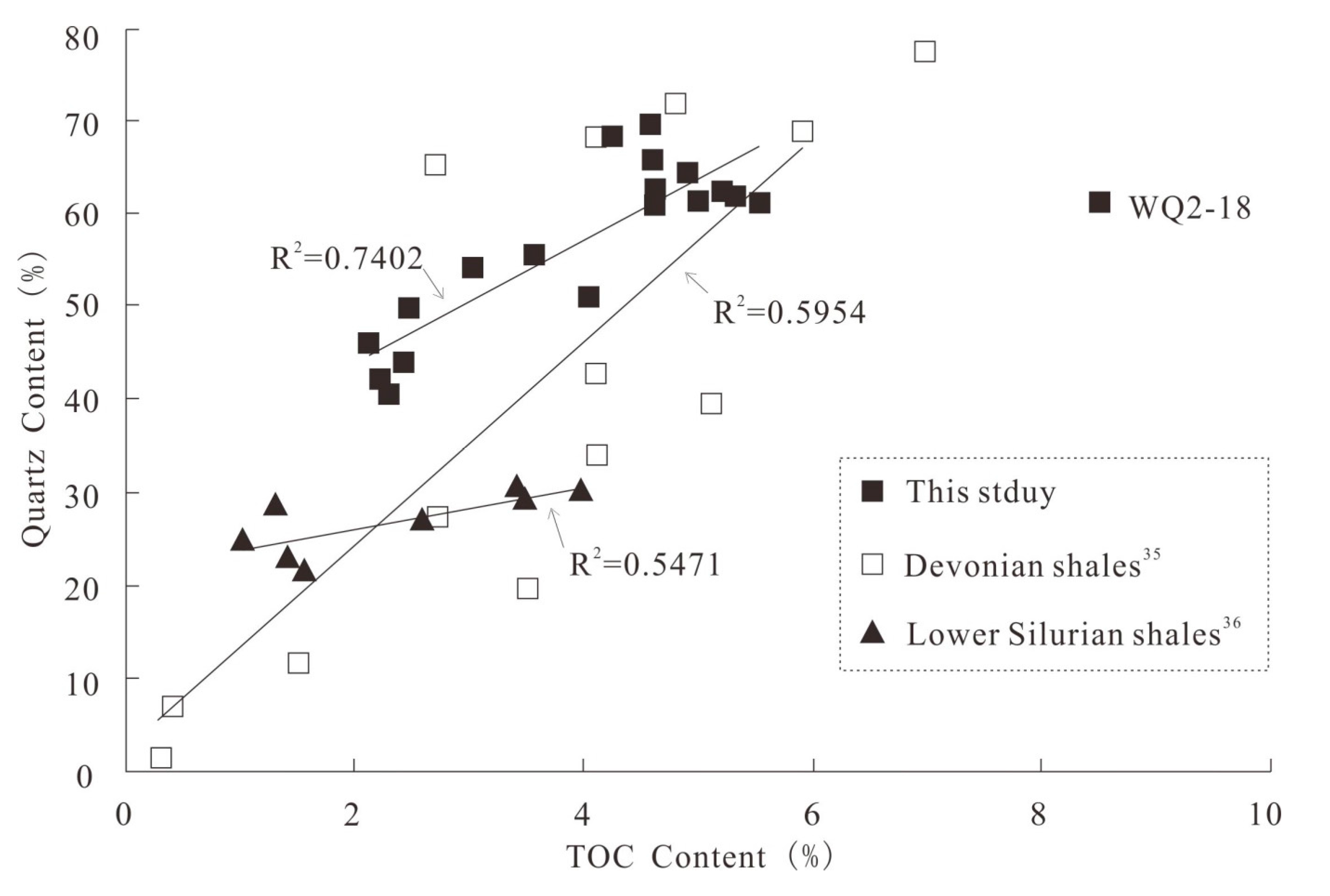
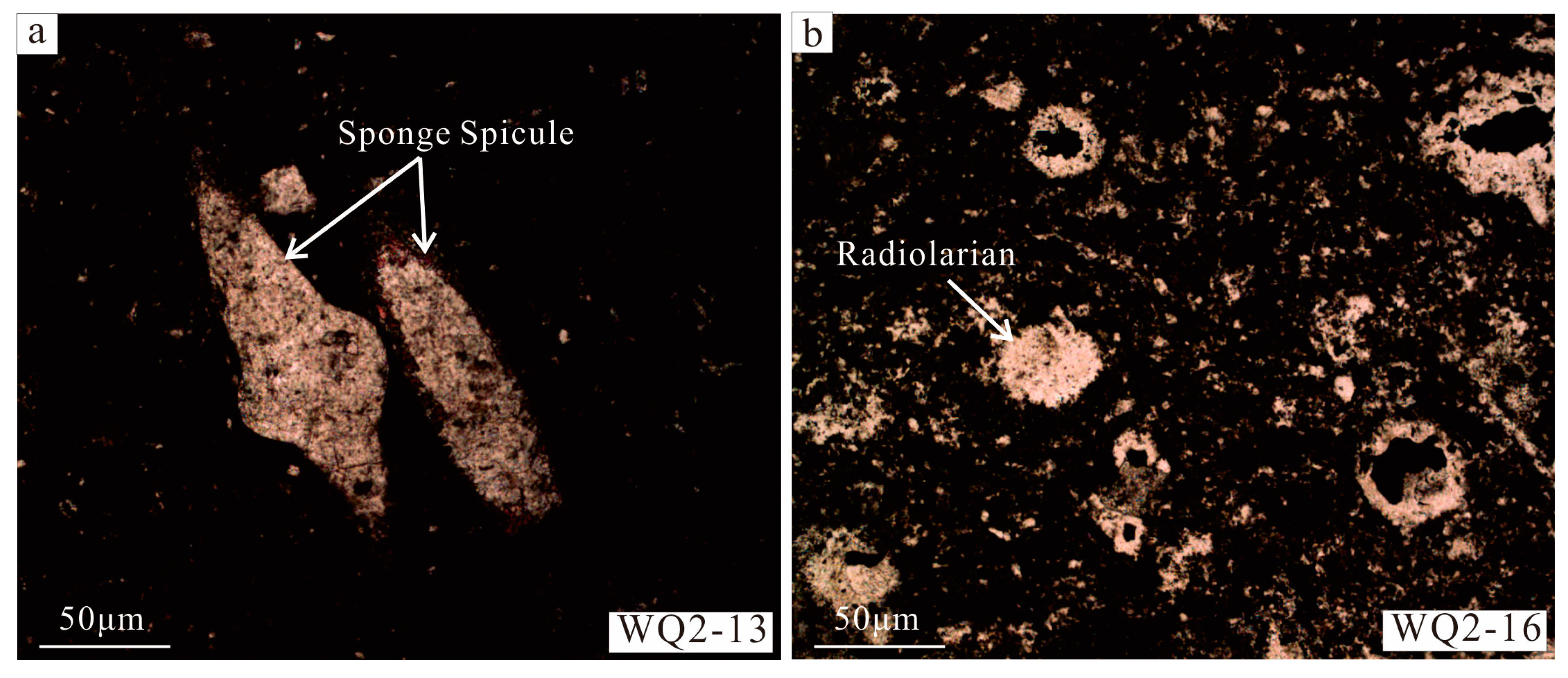
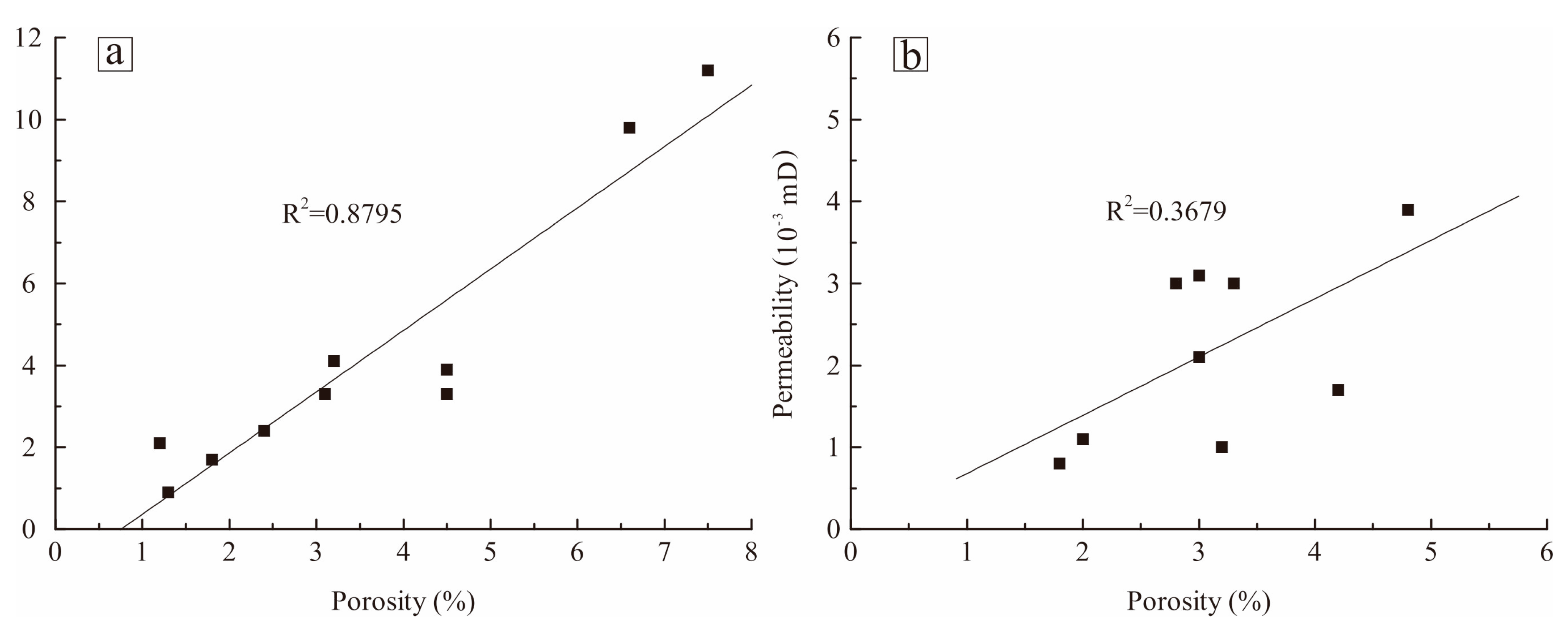

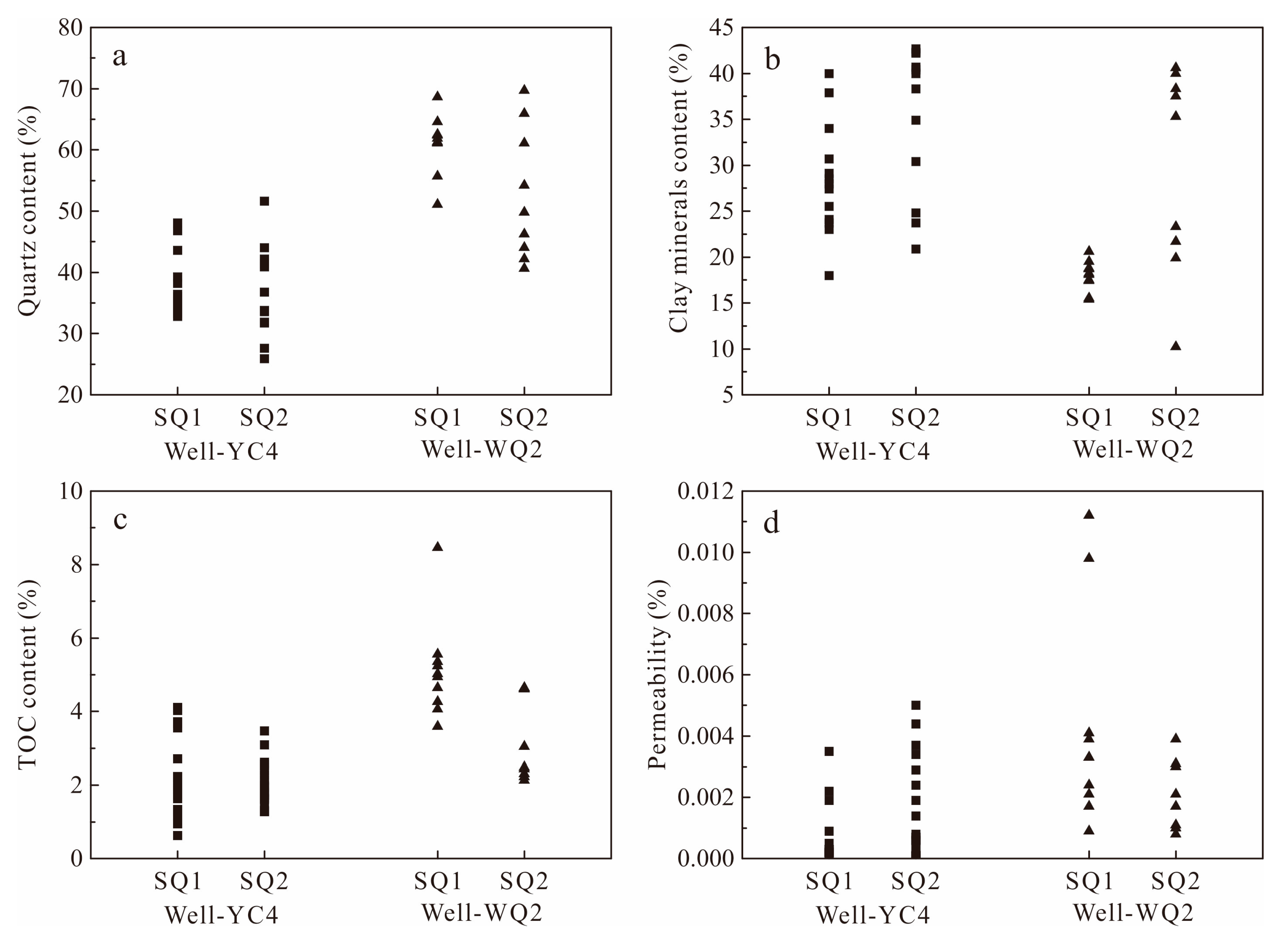
© 2017 by the authors. Licensee MDPI, Basel, Switzerland. This article is an open access article distributed under the terms and conditions of the Creative Commons Attribution (CC BY) license (http://creativecommons.org/licenses/by/4.0/).
Share and Cite
Liu, J.; Yao, Y.; Elsworth, D.; Liu, D.; Cai, Y.; Dong, L. Vertical Heterogeneity of the Shale Reservoir in the Lower Silurian Longmaxi Formation: Analogy between the Southeastern and Northeastern Sichuan Basin, SW China. Minerals 2017, 7, 151. https://doi.org/10.3390/min7080151
Liu J, Yao Y, Elsworth D, Liu D, Cai Y, Dong L. Vertical Heterogeneity of the Shale Reservoir in the Lower Silurian Longmaxi Formation: Analogy between the Southeastern and Northeastern Sichuan Basin, SW China. Minerals. 2017; 7(8):151. https://doi.org/10.3390/min7080151
Chicago/Turabian StyleLiu, Jun, Yanbin Yao, Derek Elsworth, Dameng Liu, Yidong Cai, and Li Dong. 2017. "Vertical Heterogeneity of the Shale Reservoir in the Lower Silurian Longmaxi Formation: Analogy between the Southeastern and Northeastern Sichuan Basin, SW China" Minerals 7, no. 8: 151. https://doi.org/10.3390/min7080151






